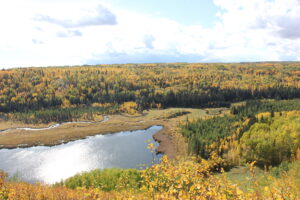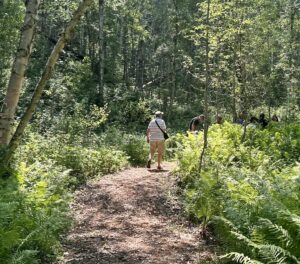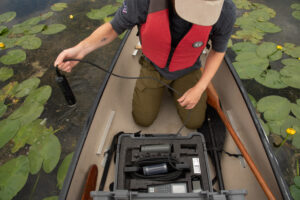The Battle River Watershed finds its source in the clear, cool waters of Battle Lake, a natural gem known for its beauty and ecological significance. Stretching approximately 6.4 kilometers in length and 0.7 kilometers in width, Battle Lake reaches a maximum depth of 13.1 meters.
Battle Lake and Battle River are prairie-fed watersheds, which means that they do not receive flow from glacier melt, but from snow melt, rain, and groundwater. This is also the headwaters for the Bigstone subwatershed, the westernmost and largest in the Battle River system. Bigstone alone covers about 7,250 square kilometers and was home to around 77,000 people in 2006, representing a significant portion of the watershed’s population.

In Plains Cree, Battle Lake is known as Wayatinâw Sâkahikan, meaning “valley lake.” The lake is an integral part of local heritage and the ancestral lands of Treaty 6 nations as well as the Metis homeland. Efforts in the 1970s to preserve the area as a Provincial Park highlight its enduring value. Named after the Battle River, the lake’s name evolved from “Battle River Lake” in 1883 to Battle Lake, which was officially adopted in 1901.
The Battle River Watershed unfolds across the Western Plains physiographic region. Mount Butte, one of the highest points in the watershed, overlooks Battle Lake. The region was carved and sculpted by glaciers during the last Ice Age. The valley that now holds Battle Lake was created by many years of glacier ice wearing away at exposed stone. The winding course of the Battle River dictates the flow and pace of water as it journeys through the area. The headwaters in the western region of the watershed are the high point in the watershed and elevations drop to the north and east. Upland areas — any area above 200 metres — mediate plain areas. In the west, the Bashaw and Beaver Hills Uplands emerge amidst the plains, while the Viking and Neutral Hills Uplands define the south-central region. The southeastern reach of the watershed rises to meet the Oyen Upland, creating a varied and dynamic landscape that influences the entire flow of the Battle River.
Source: Traversing Terrain & Experience

What sets Battle Lake apart is its unique ecology. Due to its higher elevation and Boreal Mixedwood environment, the lake and its surroundings support a diverse range of species more commonly found in boreal or mountainous regions. Visitors might encounter moose, elk, deer, black bears, cougars, bobcats, osprey, muskrats, and species such as beavers and loons on the lake. The area also hosts rare plant species such as ostrich ferns and high-bush cranberries. The land and water provide natural medicines, fish and game as sustenance for Indigenous peoples. There is a strong farming community and a significant oil and gas presence on the lake as well. With this human footprint there is a need to continue to preserve and protect the natural landscape. Examples of this have been the community-led Battle Lake Natural Area Preservation Society, Battle Lake Watershed Synergy Group, ALUS and Indigenous-led landowner restoration projects and other such projects. Battle Lake also offers a variety of recreational activities such as fishing, hiking and camping. Multiple parks and natural areas surround the lake. Mount Butte Natural Area on the northern end offers hiking trails with scenic views. Battle Lake Park is a favorite for individuals who enjoy canoeing, kayaking, paddle boarding, sailing, boating, and swimming.

As the headwaters of the Battle River, Battle Lake’s health is crucial to the entire watershed. Monitoring the lake ecosystem contributes to our understanding of water quality in the Battle River Watershed. In 2025, founding members of the Battle Lake Natural Area Preservation Society contributed funds to support the Battle River Watershed Alliance (BRWA) citizen science programs. The BRWA hosts a community science program to engage local residents and groups in monitoring and stewarding the Battle River Watershed, including its headwaters. Activities include water quality testing, lake observation, bird counts, species counts, and monitoring for invasive species. The program contributes to state of the watershed reporting.
__
This page has been made possible through the support of the Battle Lake Natural Area Preservation Society.